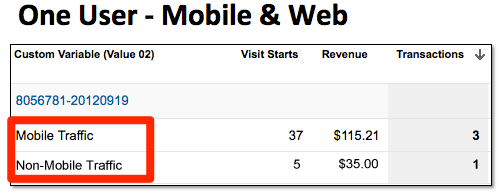Many ecommerce owners use analytics to measure page views, traffic, and conversion rates. That is all well and good, but it is old-school.
In today’s multi-device, multichannel world, marketers are finding it challenging to connect the dots between the web, mobile, and their backend data. A simplified view of the visitor’s journey to conversion just won’t cut it. There’s more to tracking consumers’ shopping and buying habits, what influenced them to visit your site, what they did while on the site, and ultimately their purchasing decisions.
Analytics are more difficult in a multichannel, multi-device world.
Understand your Shoppers’ Habits
So where do you begin? First, know your shoppers. They come from a variety of traffic sources on many devices, from laptops, home and work computers, to tablets, smartphones, and offline as well. Not only are shoppers using each of these digital devices, they are likely using them simultaneously. Look around your own household, for example, and you’ll likely see someone surfing the Internet on their laptop with their cell phone sitting next to them texting someone, while watching TV. Or perhaps you do this yourself. It is a multi-device world.
There’s another layer of complexity in gathering digital data from today’s ecommerce customers. In the traditional analytics approach, the customer who comes to your website through different browsers — Chrome, Firefox, Internet Explorer — will appear in your analytics reports as different visitors, making it extremely difficult for marketers to assess true campaign performance.
So how do you track this multi-device, multichannel shopper?
Tracking a Visitor’s Devices, Browsers
One way is to create a key — such as a user ID — and require or entice visitors to sign-in prior to each online experience, whether it is from their tablet, computer, or any other device. Google Analytics and, now, Google’s Universal Analytics allow you to report shoppers’ interactions through their journey to and through your site and digital devices. See below where we measure the purchasing behavior of one user who completed transactions utilizing three different platforms and browsers.
Some customers use more than one browser on a regular basis.
As can be seen from the above report, the same customer completed a total of six transactions. In the “traditional” analytics, those six transactions would appear as disparate activities and the ecommerce marketing manager could make erroneous conclusions about conversions and campaign performance. Now, however, the marketing manager can report on customer lifetime value and buying behavior over time.
In another example, one user has made purchases on both a mobile and a non-mobile device.
Some customers make purchases from both mobile and non-mobile devices.
In the report above, the customer is very engaged on her mobile device with 37 visits and she also completed three transactions. An ecommerce manager could, using similar data, look for what’s appealing to his shoppers on mobile, and promote it further.
As your data gets more advanced, you can apply models to groups of buyers based on behaviors and criteria. Your ecommerce environment and business model might be different for each group. For example, understanding one-time versus repeat buyers, their frequency of purchase, quantity, and amount spent is highly valuable in your web analytics platform for additional segmentation. Think through these types of scenarios to track for your ecommerce business.



